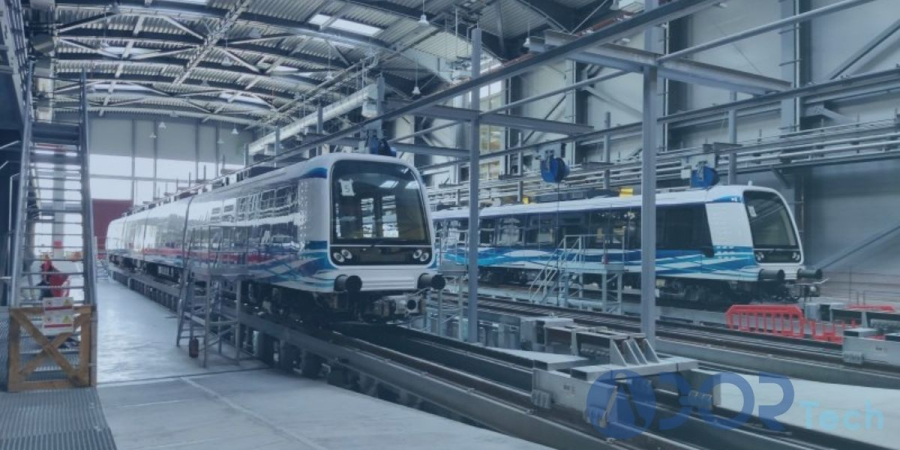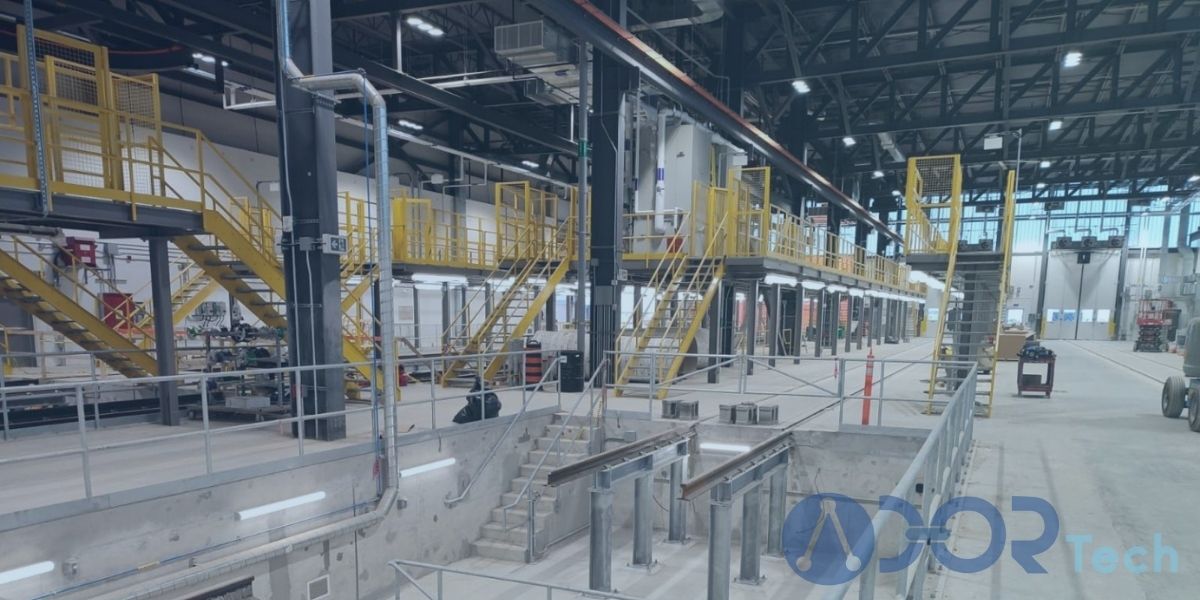
Railway infrastructure projects involve complex construction and coordination. Proper project management ensures these significant investments are completed on time and within budget. This article will overview practical techniques for managing railway construction projects, focusing on depot builds. Railway depots are critical infrastructure that provide storage, maintenance, and operations facilities for rolling stock. Constructing a depot requires extensive planning and precise execution across civil works, equipment installation, and testing phases.
This article will delve into best practices for railway depot construction management. We will examine the documentation, planning, and quality control processes for smooth project delivery. Key topics include final drawing approvals, manufacturing orders, project scheduling, material stocks, progress monitoring, factory and site testing, training, and handover procedures.
Following an introductory background on railway project management, we will provide a detailed overview of construction management specifically for depot builds. Industry standards and proven techniques will be shared to help project managers, engineers, and construction firms optimize their approach. Proper planning and management of inputs, schedules, and resources is paramount for constructing high-quality railway assets on time and within budget. This article aims to support the successful delivery of these mission-critical transportation infrastructure projects.
Explore the key sections in this article:
Why Is Project Management Important in Railway Construction?
Effective project management is critical for delivering successful railway construction projects. These large-scale infrastructure developments involve high capital costs and tight timelines, making diligent oversight and coordination essential. Railway builds encompass complex technical elements and multiple stakeholders across owners, engineers, contractors, suppliers, and regulatory bodies. Misalignments can quickly occur without structured management, leading to delays, quality issues, and budget overruns. Studies have found that inadequate project management accounts for nearly 40% of challenges in infrastructure builds. Hence, a scientific approach and best practices must be employed from planning to execution. Key aspects of project management like activity scheduling, resource allocation, change control, risk management, and progress monitoring enable efficient completion per defined parameters.
For instance, the critical path method allows optimizing tasks for sequences during methods like earned value management to help assess actual versus planned progress. Applying project management principles facilitates collaboration across all participants through structured communication and decision-making. It provides the rigour, transparency, and objectivity needed to integrate diverse project elements. In essence, project management brings the discipline to deliver railway projects safely, reliably, and cost-effectively. It is an indispensable practice for translating strategic vision into tactical reality through coordination, control, and governance of people, processes, and resources.
Check out our "Railway Engineering Services" for more information.
Key Phases in Railway Construction Management

Successfully managing major railway construction requires structured planning and execution across crucial phases, including Planning and Documentation, Materials Management, Quality Control, Logistics Planning, Installation Planning, and Training and Handover. The Planning and Documentation phase involves finalizing all design drawings, manufacturing orders, schedules, and procedures. Materials Management encompasses procurement, vendor selection, manufacturing oversight, and monitoring stocks and progress. Quality Control involves developing and conducting factory and site acceptance tests and inspections. Logistics Planning covers all transportation, loading, unloading, and import/export tasks. Installation Planning involves method statements, equipment integration, and civil works. Finally, Training and Handover include operator and maintenance instructions and asset delivery. Breaking the project into these distinct stages allows focused management of each component.
In this part, we will explain these phases in detail, covering the processes and best practices essential for on-time, on-budget delivery of railway projects. A phased management approach provides the structure, clarity, and rigor for successful infrastructure development.
Planning and Documentation Phase in Railway Construction Management
The Planning and Documentation phase lays the groundwork for efficient execution by consolidating all design, planning, and process information. Key activities include:
1- Final Drawings Approval
All stakeholders must finalize and approve the civil, mechanical, electrical, and interface engineering drawings. This confirms dimensions, specifications, system integration, and other technical aspects before procurement and construction. Reviews ensure the drawings match railway standards and end-user requirements.
2- Manufacturing Orders
Vendors and suppliers can issue manufacturing and fabrication orders with the final drawings. These purchase orders have precise technical specifications, delivery timelines, quality expectations, and payment terms. Procurement should commence shortly after final approvals to meet project schedules.
3- Gantt Charts and Project Scheduling
Detailed Gantt charts covering the engineering, procurement, construction, testing, and commissioning activities must be developed. This overall schedule identifies milestones, critical paths, resource allocations, and a timeline for deliverables. Project planning tools like PERT can optimize task sequencing.
4- Technical Documentation
All operating procedures, maintenance manuals, testing protocols, and training materials must be compiled and finalized. This documentation is crucial for validating systems, regulatory compliance, asset handover, operations readiness, and maintenance.
The Planning and Documentation phase consolidates all requisite plans, orders, drawings, and information to set up railway project execution for success. The attention to detail ensures every specification and activity is premeditated before deployment.
Materials Management Phase in Railway Construction Projects
The Materials Management phase oversees the purchasing, fabrication, quality control, and delivery of all equipment and components needed for the project. Key activities include:
1- Material Stocks and Procurement
Based on final equipment lists and manufacturing orders, all materials and items are procured per specifications. Inventory is tracked and stocked at locations convenient for just-in-time delivery during installation. Procurement milestones are aligned with construction schedules.
2- Manufacturing Progress Monitoring
Manufacturing and fabrication of custom equipment are monitored closely. Engineers conduct site visits and inspections to ensure on-time progress and conformance to railway standards. Early identification of delays or quality issues is critical.
3- Progress Reports
Materials managers compile progress reports tracking procurement status, manufacturing, quality checks, and materials delivery. These highlight milestones achieved and flag any schedule risks or deviations for mitigation.
Oversight of equipment supply and fabrication is continuous throughout the Materials Management phase. The rigorous monitoring and control ensure procurement aligns with project timelines while meeting stringent railway quality expectations. Proactive materials management de-risks equipment availability for installation and commissioning phases.
Quality Control Phase in Railway Construction Projects
The Quality Control phase involves extensive testing, inspections, and reviews to verify all components and systems meet railway standards before deployment. Key activities include:
1- Factory Acceptance Testing (FAT)
FAT evaluates equipment operation and performance at the manufacturer facility through simulated conditions and use cases. Items are checked against requirements specifications in the design. Issues can be corrected before shipment.
2- Site Acceptance Testing (SAT)
SAT repeats equipment validation in the field after installation is complete. This verifies proper assembly, electrical interfaces, integration software, safety mechanisms, and other on-site functionalities.
3- Test Procedures and Reports
Standardized test procedures are developed for FAT and SAT with pass/fail criteria. Detailed reports document results and highlight any non-conformities for correction. These reports are reviewed for final regulatory and client acceptance.
Rigorous quality control safeguards railway construction from defects affecting safety, operations, and asset longevity. Ensuring equipment withstands real-world conditions provides confidence before commencing live operations. This phased verification approach is an industry best practice.
Logistics Planning Phase in Railway Construction Projects
The Logistics Planning phase coordinates the transportation, delivery, customs clearance, and handling of all physical components to the construction site. Key activities include:
1- Transport Documents and Planning
Transport plans detail the routing, loading, environmental/safety precautions, and equipment needed for moving materials. Permits, wayleave agreements, and police escorts may be required.
2- Photo Reporting
Photo and video documentation tracks components in transit and arrival at the site to record conditions and confirm deliveries.
3- On-Site Verification
Upon arrival, materials are meticulously checked against orders and transport documents to verify accuracy, quality, and quantity.
4- Import/Export Documentation
For international projects, customs clearances, duties payments, and filings ensure imported equipment and materials arrive on time. Export documents are handled for any outbound items.
Logistics planning minimizes delays by coordinating seamless pick-up, transport, clearance, and delivery of railway materials. The phase oversees the secure, damage-free movement of components to the project site ready for installation.
Installation Planning Phase in Railway Construction Projects
The Installation Planning phase maps out the safe, sequenced, and integrated installation of all on-site infrastructure, equipment, and components. Key activities include:
1- Method Statements
Detailed method statements outline the step-by-step process, specifications, and safety precautions for installation teams to follow. This ensures proper assembly and configuration of equipment.
2- Equipment Interfaces
Interface management protocols are prepared to coordinate and validate the interconnections between electrical, signaling, mechanical, and other systems. Testing verifies integration functionality.
3- Civil Works Requirements
Civil works and site preparation requirements are finalized to enable equipment mounting as per design plans and load-bearing needs. Surveyor checks confirm dimensions.
Careful installation planning provides clear direction to construction crews on workflow sequencing, system connections, safety measures, and quality needs. The phase sets up safe, efficient assembly and integration of railway components - translating plans into physical assets.
Training and Handover Phase in Railway Construction Projects
After project completion, the Training and Handover phase prepares the client's teams to safely operate, maintain, and manage the new railway assets. Key activities include:
1- Operator Training
Comprehensive training programs for drivers, controllers, signallers, and other operations personnel to gain proficiency with new systems and infrastructure.
2- Maintenance Training
Technical maintenance teams are trained in equipment servicing, troubleshooting, repair procedures, and preventative maintenance.
3- Asset Handover Procedures
Formal handover protocols transfer custody of infrastructure, technology, spare parts, warranties, documentation, and O&M liability from the construction firm to the railway owner.
The Training and Handover phase equips the client's organization with the skilled staff, documentation, and procedures needed to utilize the railway assets independently, safely, and effectively over the entire lifecycle. A thorough knowledge transfer and transition process is vital for project closure.
Conclusion
Railway infrastructure projects represent significant investments that enable economic growth and transportation for communities. However, their success hinges on diligent project management across all stages, from design to handover. This concludes our overview of best practices for managing railway construction, focusing on depot builds.
We have covered the key phases, processes, and activities that allow project managers to deliver these complex developments on time, within budget, and to the highest standards. A phased approach provides the structure to coordinate many moving parts - from finalizing drawings to procurement, installation, testing, training, and asset delivery. When activities are carefully aligned and monitored within each phase, seamless execution is possible.
Advanced preparation and planning are crucial. Documentation like technical drawings, equipment orders, schedules, manuals, and procedures should be comprehensive. Materials management must balance timely procurement with quality oversight of manufacturing. Rigorous testing and inspections prevent defects. Logistics optimization reduces delays in moving components to the site. Effective installation coordination maximizes efficiency while minimizing risks. Training programs and handover protocols ensure the client can safely operate and maintain the railway.
With significant capital outlays and multi-year timeframes, problems can quickly escalate in railway projects. This underscores the need for scientific project management based on industry best practices. Infrastructure projects can unfold predictably when critical processes are proactively defined, managed, and monitored. Teams are empowered to identify issues early and course correct.
We hope this overview provides a blueprint for infrastructure project managers to deliver successful railway assets. These skills will be vital with the growing demand for rail transportation worldwide. By implementing robust construction management, railway owners and operators can keep these projects on track in all respects. The result will be rail infrastructure that has served communities efficiently for decades.